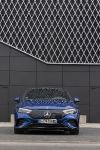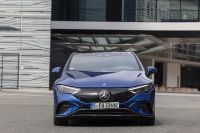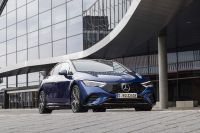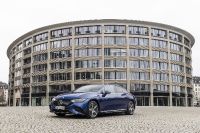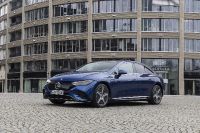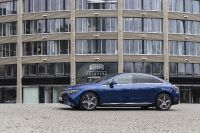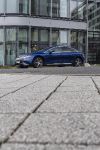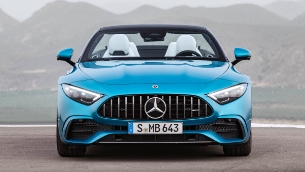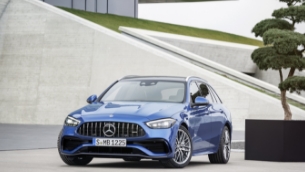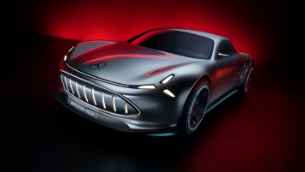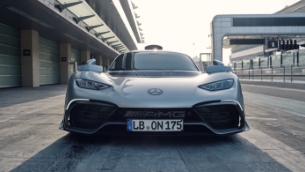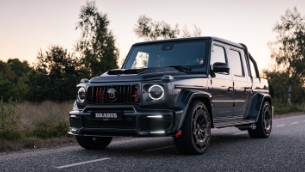The EQE: the new business avant-garde
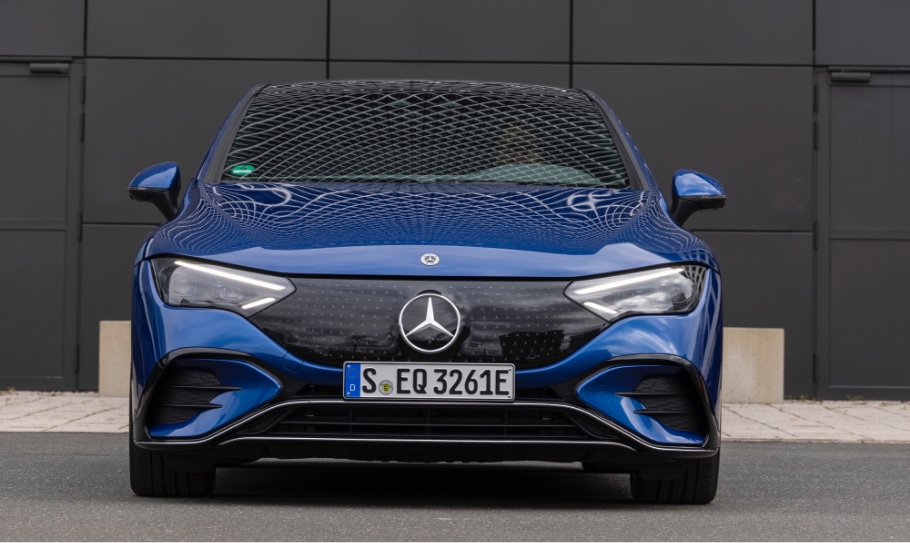
Hot on the heels of the EQS, Mercedes-EQ is already presenting the next model series to be based on the electric architecture developed specifically for electric vehicles, the new EQE. The sporty business saloon offers all the essential functions of the EQS in a slightly more compact format. At market launch in late April 2022, the model line-up will initially comprise two variants: the EQE 350+ (WLTP: combined electrical consumption: 18.7-15.9 kWh/100 km; combined CO2 emissions: 0 g/km)[1] with 215 kW and the Mercedes-AMG EQE 43 4MATIC (WLTP: combined electrical consumption: 22.5-19.7 kWh/100 km; combined CO2 emissions: 0 g/km)[1]. With 350 kW, this is the entry-level model for electric Driving Performance from Mercedes-AMG. The EQE 500 4MATIC (provisional figures WLTP: combined electrical consumption: 21.1-17.8 kWh/100 km; combined CO2 emissions: 0 g/km) [2] and Mercedes-AMG EQE 53 4MATIC+ (provisional figures WLTP: combined electrical consumption: 23.2 - 20.3 kWh/100 km; combined CO2 emissions: 0 g/km) will follow. Production of the EQE takes place at two locations of the Mercedes-Benz Cars global production network: at the German Mercedes-Benz plant in Bremen for the global market and at the German-Chinese joint venture BBAC in Beijing for the local market.
Compared to the luxury liner EQS, the EQE is even more streamlined, with a slightly shorter wheelbase, shorter overhangs and more recessed flanks - it carries the concept of the business saloon into the future. Sensual Purity is reflected in generously modelled surfaces, reduced joints and seamless transitions (seamless design). The overhangs and the front end are kept short, the rear provides the dynamic accent with a sharp rear spoiler. Flush with the outer edge of the body, the 19- to 21-inch wheels, together with a pronounced muscular shoulder section, give the EQE an athletic character.
In its outer dimensions (length/width/height: 4946/1961/1512 millimetres), the EQE is comparable to the CLS. Like the latter, it has a fixed rear window and a boot lid. The interior dimensions even exceed those of today's E-Class (213 model series) quite significantly, e.g. in terms of the shoulder room in the front (plus 27 mm) or the interior length (plus 80 mm).
Unconventional interior design and high operating convenience
With the optionally available MBUX Hyperscreen, the entire instrument panel is a single, ultimate widescreen. This determines the aesthetics of the entire cockpit and interior. The high-resolution screens merge seemingly seamlessly under the shared glass cover. The graphic appearance of their MBUX content is perfectly coordinated. The MBUX Hyperscreen is integrated into the instrument panel in minimalist fashion.
The 12.3-inch OLED display for the front passenger gives them their own display and control area. In Europe and in a growing number of countries, the passenger is allowed to watch dynamic content such as videos, TV or the internet even while on the move. This is because Mercedes-EQ is able to rely on an intelligent, camera-based blocking logic: if the camera detects that the driver is looking at the front passenger display, this is automatically dimmed for certain content.
The vent band spans across the entire width at the top and is very slim at the same time. These extreme proportions, together with the glass wave of the MBUX Hyperscreen, create the avant-garde architecture of the cockpit. The outer nozzles feature a turbine design. They play on the theme hyperanalogue through the contrast between high-tech precision mechanics and digital, glass display world.
The latest MBUX generation, recently introduced in the EQS, is also on board the EQE. With adaptive software, the control and display concept completely adapts to its user and makes personalised suggestions for numerous infotainment, comfort and vehicle functions. With the zero-layer design, the user does not have to scroll through submenus or give voice commands. The most important applications are offered situationally and contextually on the top level in the field of view. In this way the EQE driver is relieved of certain operating steps.
Efficient drive system
The first models to come onto the market at the end of April 2022 will be the EQE 350+ with 215 kW and the Mercedes-AMG EQE 43 4MATIC with 350 kW. The EQE 500 4MATIC with 300 kW and the Mercedes-AMG EQE 53 4MATIC+ with up to 505 kW will follow. All EQE models have an electric drivetrain (eATS) on the rear axle. The versions with 4MATIC are also equipped with an eATS at the front axle. The electric motors are permanently excited synchronous motors (PSM). With the PSM, the rotor of the AC motor is fitted with permanent magnets and therefore does not need to be supplied with power. The advantages of this design include high power density, high efficiency and high power constancy. The motor on the rear axle is particularly powerful due to its six-phase design: it has two windings with three phases each.
In the EQE 350+, the lithium-ion battery is made up of ten modules and has a usable energy content of 90 kWh. The innovative battery management software, developed in-house, allows updates over the air (OTA). In this way, the energy management of the EQE remains up-to-date throughout the life cycle.
With this generation of batteries, a major step has been achieved in terms of the sustainability of the cell chemistry: The optimised active material consists of nickel, cobalt and manganese in a ratio of 8:1:1. This reduces the cobalt content to less than ten percent. The continuous optimisation of recyclability is part of Mercedes-Benz's holistic battery strategy.
Key technical data
| EQE 350+[3] | EQE 500 4MATIC[4] | |||
| Drive system | ||||
| Electric motor | Type | Permanently excited synchronous motor | Permanently excited synchronous motor | |
| Output | kW | 215 | 300 | |
| torque | Nm | 565 | 858 | |
| Rated voltage | Volts | 328.5 | 328.5 | |
| On-board charger (standard/optional) | kW | 11/22 | 11/22 | |
| AC charging time, three-phase (11/22 kW) | h | 8,25/4,25 | 8,25/4,25 | |
| DC charging capacity, max. | kW | 170 | 170 | |
| DC charging time at quick-charging station[5] | min | 32 | 32 | |
| DC charging: max. range after15 minutes[6] (WLTP) | km | 250 | 230 (provisional) | |
| Vehicle | ||||
| Length/width/height | mm | 4.946/1.961/1.510 | 4.946/1.961/1.510 | |
| Length/width/height (USA) | mm | 4.995/1.961/1.511 | 4.995/1.961/1.511 | |
| Wheelbase | mm | 3120 | 3120 | |
| Turning circle (without/with rear-axle steering 4.5°/10°) | m | 12.5/11.6/10.7 | 12.5/11.6/10.7 | |
| Boot capacity, VDA | l | 430 | 430 | |
| Power consumption and range | ||||
| Power consumption (WLTP) | kWh/100 km | 18.7-15.9 | 21.1-17.8 (provisional) | |
| CO2 emissions (WLTP) | g/km | 0 | 0 | |
| Range (WLTP) | km | 567-654 | 503-590 (provisional) | |
Consistently high performance and multiple accelerations without a drop in power characterise the EQE's drive philosophy. This includes a sophisticated thermal concept and several variants of energy recovery by means of recuperation. In this process, the high-voltage battery is charged by converting the mechanical rotary motion into electrical energy during overrun or braking mode. The driver can manually select the deceleration in three stages (D+, D, D-) as well as the gliding function via shift paddles behind the steering wheel. Also available: DAuto.
ECO Assist also offers situation-optimised recuperation - deceleration is so strong or weak that it ultimately results in the most efficient driving style. If possible, recuperative deceleration is also used for vehicles detected ahead. This even occurs until they come to a standstill, for example at traffic lights. The driver does not need to press the brake pedal for this - literally one-pedal driving.
Navigation with Electric Intelligence plans the fastest and most convenient route, including charging stops, based on numerous factors and reacts dynamically to traffic jams or a change in driving style, for example. This includes a visualisation in the MBUX infotainment system as to whether the available battery capacity is sufficient to return to the starting point without charging.
High noise and vibration comfort, Sound Experiences as a contrast
As a saloon with a boot lid, the EQE's concept is well equipped to offer a high level of NVH comfort Noise, Vibration, Harshness) into account. Numerous measures contribute to this. In the electric drivetrains (eATS), the magnets are arranged inside the rotors in an NVH-optimised way (known as 'sheet metal cut'). In addition, the eATS have a special foam mat all around as an NVH cover. The inverter cover is a sandwich construction. The eATS are double-decoupled from the body via elastomeric bearings:
Highly effective spring/mass components provide continuous sound insulation from the crossmember under the windscreen to the floor of the boot. Acoustic foams are inserted into many carriers during body-in-white construction.
If desired, the ride in the EQE nevertheless becomes an acoustic experience: if the Burmester® 3D surround sound system is fitted, the EQE features the two soundscapes Silver Waves and Vivid Flux. Silver Waves is a sensuous and clean sound. Aimed at EV enthusiasts, Vivid Flux is crystalline, synthetic yet humanly warm. They can be selected or switched off as sound experiences on the central display. The additional soundscape Roaring Pulse can be activated as an over-the-air update. This sound experience is reminiscent of powerful machines, and is sonorous and extroverted.
Air suspension and rear-axle steering as options
The suspension of the new EQE, with four-link front suspension and multilink rear suspension, is closely related in design to the new S-Class. As an option, the EQE is available with AIRMATIC air suspension with ADS+ adaptive damping system. With rear-axle steering (optional extra), the EQE feels as manoeuvrable as a compact car in the city. The steering angle at the rear axle is up to ten degrees. The turning circle is reduced from 12.5 to 10.7 metres with rear-axle steering.
New vehicle functions can be activated via over-the-air technology (OTA). Available from launch: the additional sound experience "Roaring Pulse", two special driving modes for young drivers and service personnel, small games, the highlight mode as well as DIGITAL LIGHT with projection function and DIGITAL LIGHT individualisation. In Highlight mode the vehicle presents itself and its equipment highlights - this can be activated via the "Hey Mercedes" voice assistant. In addition to the light animation "Digital Rain", DIGITAL LIGHT individualisation includes other coming-home/leaving animations such as "Brand World". The OTA functions are available in the Mercedes me Store, and the range will be successively expanded.
Convenient charging in a large charging network
With the new Mercedes me Charge Plug & Charge function, the EQE can be charged even more conveniently at Plug & Charge-enabled public charging points: when the charging cable is plugged in, the charging process starts automatically; no further authentication by the customer is required. The vehicle and the charging station communicate directly via the charging cable.
What's more, Mercedes me Charge customers continue to benefit from the integrated payment function with automatic payment. The customer chooses the preferred payment method only once. Every charging process is then automatically debited – including abroad. The individual charging processes are clearly listed in a monthly invoice.
Mercedes me Charge is one of the largest charging networks worldwide: it currently comprises around 700,000 AC and DC charging points worldwide, of which more than 300,000 are in Europe. By means of high-quality certificates of origin, Mercedes-Benz guarantees that energy from renewable energy sources is fed into the grid for charging current sourced via Mercedes me Charge.
High level of passive and active safety
The principles of Integral Safety, in particular accident safety, apply regardless of the platform. Like all other Mercedes-Benz models, the EQE therefore has a rigid passenger cell, special deformation zones and modern restraint systems with PRE-SAFE®.
The fact that the EQE is based on an all-electric architecture also opened up new design possibilities for its safety concept. It meant, for example, that a favourable location could be chosen for the installation of the battery, in a crash-protected area in the underbody. And because there is no large crankcase on board, the behaviour in a frontal crash could be modelled even better. In addition to the standard crash tests, the car's performance in various additional load situations was verified and extensive component tests carried out at the Vehicle Safety Technology Centre (TFS).
The latest generation of driving assistance systems includes numerous driver support functions. One new function is the additional microsleep warning from ATTENTION ASSIST (in conjunction with MBUX Hyperscreen). It analyses the driver's eyelid movements using a camera in the driver display. The assistance display within the driver's display shows the operation of the driving assistance systems in a comprehensible full-screen view.
Mercedes management on the EQE
"After the EQS, the EQE is already the second model to be built on our new platform for electric vehicles. This speed of innovation shows the advantages of the scalable architecture: With the new EQE, we can quickly make the high-tech solutions of our electric flagship EQS available to a wider group of buyers. And our production flexibility reaches new heights with the EQE: at the Bremen plant, where the versions for the world market roll off the production line, ten other models are already in production." Markus Schäfer, Member of the Board of Management of Mercedes-Benz Group AG and COO of Mercedes-Benz Cars
"With its dynamic driving experience and comprehensive range of Connected Services, the EQE is a perfect fit for the desires of a modern generation of customers. We reconcile innovation and emotionality with sustainability: with Green Charging, we are actively contributing to the reduction of CO2 emissions. In addition, there are numerous intelligent functions that make everyday life easier for our customers. This includes Plug & Charge, for example - plug in and the EQE is charged without further authentication or registration." Britta Seeger, Member of the Board of Management of Mercedes-Benz Group AG and Mercedes-Benz AG, responsible for Mercedes-Benz Cars Marketing and Sales
"The Mercedes EQE is the next electric luxury saloon. The hallmark one-bow design, finely sculpted lines and silhouette together create a very aerodynamic and futuristic look. It all adds up to make the EQE a more extravagant, more entertaining and more exceptional car, while at the same time defining the next luxury class for the Mercedes-EQ brand." Gorden Wagener, Chief Design Officer Mercedes-Benz AG
"The Mercedes-EQ brand is pursuing an ambitious and equally clear goal: We want to build the most sustainable and technically most advanced cars in the world. By bringing responsible innovations onto the road, we are driving forward this process of transition. The EQE is the latest example of this – and its contribution will be significant." Christoph Starzynski, Vice President Electric Vehicle Architecture & Head of Mercedes-EQ
[1] Range and electrical consumption have been determined on the basis of Commission Regulation (EC) No. 2017/1151/EU.
[2] Data on electrical consumption and range are provisional and were determined internally in accordance with the "WLTP test procedure" certification method. Confirmed TÜV figures, EC type approval and certificate of conformity with official figures are not yet available. Differences between the stated figures and the official figures are possible.
[3] Range and electrical consumption have been determined on the basis of Commission Regulation (EC) No. 2017/1151/EU.
[4] Data on electrical consumption and range are provisional and were determined internally in accordance with the "WLTP test procedure" certification method. Confirmed TÜV figures, EC type approval and certificate of conformity with official figures are not yet available. Differences between the stated figures and the official figures are possible.
[5] The charging times are for a 10-80% charge at a DC fast charging station of category "K" or "L" pursuant to EN17186 with 500 A charging current
[6] At DC fast charging stations with 500 amps based on provisional WLTP range
